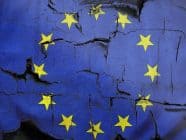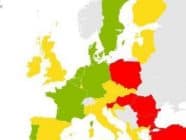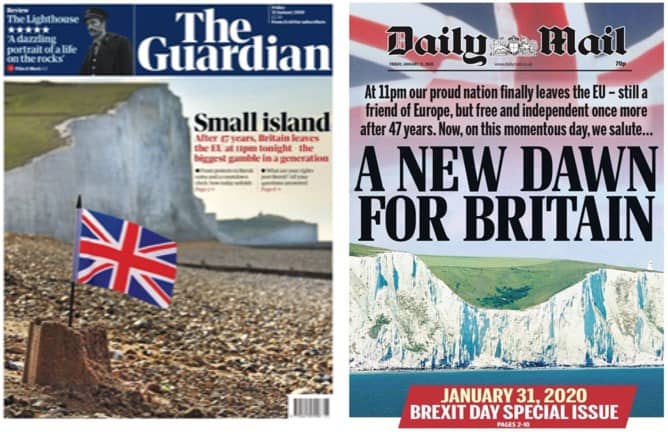
Two British papers used an image of the white cliffs of Dover on their front pages, but framed it in a very different way.
Media across Europe used “Brexit Day” – 31 January, the day on which the United Kingdom officially ceased to be a member of the European Union – to take stock of what Britain’s departure meant for their own country and the rest of the EU.
There was much talk of the uncertainties that still remain and of how much will hinge on the trade agreement that has to be concluded before the transition period ends on 31 December 2020.
The mood in Europe’s press was in general one of sadness, though a few commentators took a slightly more positive view, suggesting that the experience of Brexit offered an opportunity to learn some important lessons that might benefit Europe in the long term.
There were also a few glimmers of humour, especially in Germany’s Frankfurter Allgemeine Zeitung (FAZ), which highlighted some of the typically British things most likely to be missed by Europeans.
The seven EJO partners who took part in this survey looked at a range of newspapers and news websites (wherever possible, with different political alignments) and analysed their Brexit-related content on two days: 31 January and 1 February.
In the text that follows, some links are provided to news websites and to online versions of newspaper articles. Readers should bear in mind that printed and online versions of newspaper articles often have different headlines, and that print versions of articles often do not appear until the day after the online version.
 United Kingdom
United Kingdom
The way in which the issue of Brexit has divided British society into opposing camps was perfectly captured by the front pages of two newspapers, the Guardian and the Daily Mail, on 31 January. Both front pages featured an illustration of the white cliffs of Dover, often seen as forming a symbolic guard against invasions from continental Europe. However, this iconic image was treated in a very different way by both papers.
The left-leaning Guardian, which was opposed to Brexit from the very outset, counterpointed a blurred image of the cliffs with the apologetic headline “Small island”, described Britain’s departure from the EU as “the biggest gamble in a generation”, and featured a solitary Union Jack flag planted on the beach. The right-wing tabloid Daily Mail, which has long campaigned for Brexit, carried the bold headline “A New Dawn For Britain”, over an image of the cliffs in sharp focus and with the colours of the Union Jack occupying most of the sky.
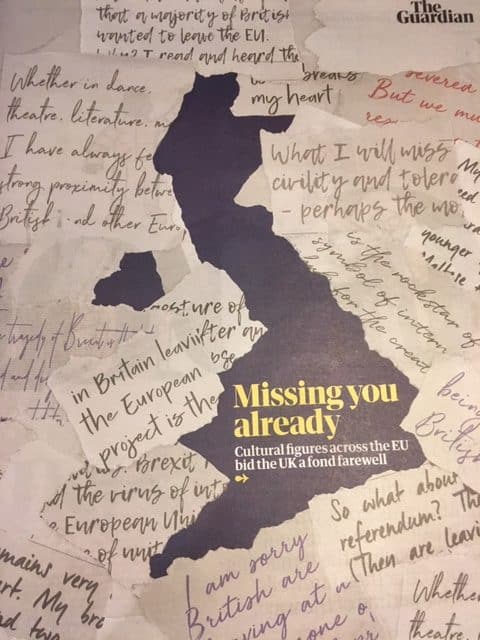
A special souvenir supplement in the Guardian consisted of “27 letters from Europe”.
The right-wing broadsheet Daily Telegraph, which like the Daily Mail has been consistently in favour of Brexit, opted for a rather less imaginative and eye-catching front page. Its headline consisted of a quotation from Prime Minister Boris Johnson’s “Brexit Day” speech, “This is not an end, but a beginning”, illustrated by a photo of Johnson himself.
All three papers carried extensive coverage on their inside pages. The tone of the Guardian’s coverage was mostly resigned and elegiac, while that of the Telegraph and Daily Mail was upbeat and occasionally triumphalist (for example, comment pieces in the Telegraph by Brexit Party leader Nigel Farage and in the Daily Mail by controversial right-wing columnist Richard Littlejohn).
On 1 February, all three papers continued to cover the issue in much the same vein as on the previous day.
The Guardian carried a front-page editorial by regular columnist Jonathan Freedland under the headline “The day we said goodbye”. This edition of the paper also included a special souvenir supplement consisting of “27 letters from Europe” – fond farewell notes from cultural figures from across the EU.
The Telegraph also offered a special souvenir supplement, in this case headlined “Brexit: what next?” Most of the articles concluded that Britain can look forward to a rosy future outside the EU.
The Daily Mail chose to focus on Leave supporters’ jubilant celebrations on “Brexit Day”. The front page carried the headline “ZERO HOUR / Downing St countdown clock shows moment we left the EU for good”. Inside the paper, the “full historic story” of Britain’s departure is told over eight pages.
 Czech Republic
Czech Republic
In the Czech media, Brexit Day provided a brief distraction from coronavirus, the topic then dominating the news agenda. Britain’s departure from the EU did not receive the same saturation coverage as was given to the shock result of the Brexit referendum back in 2016, but it still featured prominently in most media outlets. Several papers carried images of scenes of celebration in London on their front pages; the tabloid Blesk ran a picture gallery of more than 100 such images on its website.
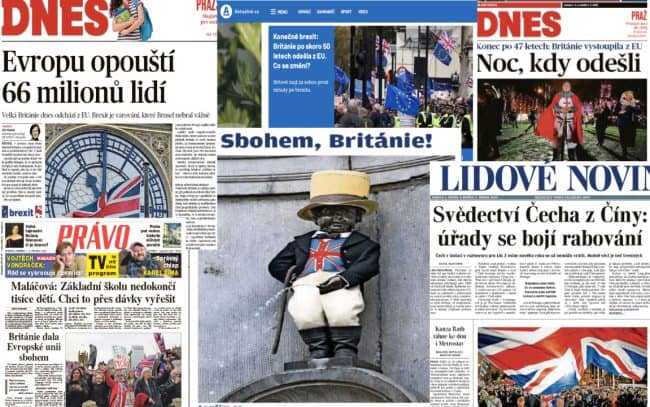
Several Czech papers featured Brexit Day on their front pages.
As was the case with the referendum, the tone of coverage was on the whole negative, with many outlets expressing concern over the likely impact of Brexit on the UK, the Czech Republic and the rest of the EU. However, several media struck a somewhat more positive note by quoting from Boris Johnson’s Brexit Day address to the nation, in particular the words: “This is not an end, but a beginning.”
Czech papers mostly focused on informing their readers about the details of the agreement between the UK and the EU, frequently pointing out that Britain’s departure will not be complete until the transition period ends on 31 December. They also dwelt on the situation of Czech citizens resident in the UK and on future trade relations between the Czech Republic and the UK.
The centre-right daily Lidove Noviny compared Britain’s turning away from the EU to the division of Czechoslovakia in 1992. The paper noted that both events brought to an end a period of squabbling, but that the Czech and Slovak Republics eventually came together again when both joined the EU.
 Germany
Germany
Germany’s two leading serious dailies, the Munich-based Süddeutsche Zeitung (SZ; centre-left) and Frankfurter Allgemeine Zeitung (FAZ; conservative) reported extensively on “Brexit Day”, giving the event prominence on their front pages and “topic of the day” pages as well as in the politics and economics sections of the papers. Of the two, FAZ gave the event the fullest coverage.

According to FAZ, saying goodbye to British eccentricity will be tough for the rest of Europe.
Most articles focused on future trade relations between the UK and both Germany and the European Union as a whole. Süddeutsche Zeitung wrote on 31 January: “Although the United Kingdom has more to lose in economic terms than the EU, a hard Brexit would also cause a good deal of pain to many member states.”
Though fear of a “hard Brexit” was a recurring theme, FAZ also provided a forum to voices that see Brexit not only as a loss but also as a potential gain. Germany may “have lost an important partner” but if as a result of Brexit the UK deregulates and adopts a simpler taxation system, “the EU should see this as an opportunity” as “excessive EU regulation” would have to be curbed in order for the bloc to be competitive, one commentator argued.
The German tabloid BILD was too preoccupied with the latest news about the spread of the coronavirus to pay much attention to Brexit. On 31 January, a short article headlined “Brexit, now for real” looked at the changes it will bring about. The following day, an even shorter article reported that Brexit is “now official”.
SZ and FAZ, on the other hand, pointed out that the real work – achieving a trade deal – is only just beginning and that for the UK, the “Brexit Day” party is now over. In both papers, the prevailing mood was one of grief at Britain’s departure.
Very few articles broached the topic of the future of the European Union. An exception was an article in Süddeutsche Zeitung on 1 February, in which the author pointed out that the EU should not look on Brexit as simply “a British spectacle” but should pay heed to its own problems and divisions.
In addition to all the talk of difficulties and uncertainties, some of the coverage was also designed to raise a wry smile. In its culture section , FAZ ran a piece headlined “Bye bye love”, in which it listed some of the peculiarly British phenomena that will from now on be missing from the “European Club”: cucumber sandwiches, “English Week” at Aldi, BBC sitcoms – and the British sense of humour.
 Italy
Italy
The Rome-based moderately left-of-centre La Repubblica carried extensive Brexit-related coverage over both days. The paper’s offering included both practical step-by-step guides to what will happen next and opinion pieces setting out the psychological impact of the UK’s departure from the European Union. La Repubblica also took a more “European” perspective with translations of articles published by partner media outlets in other countries, as well as interviews with British political figures such as Scottish First Minister Nicola Sturgeon and former British Prime Minister Tony Blair.

Taking the long view: a commentator in Corriere della Sera notes that ever since the classical era, Britain has often seemed to be set apart from the rest of the world.
The Milan-based centrist Corriere della Sera also offered its readers both practical information (mostly on 31 January) and opinion pieces (mostly on the 1 February). It summarised the course of events leading up to Britain’s official departure from the EU, and at the same time carried interviews both with politicians and writers who have been involved in the process and with Italians resident in the UK. Commentators sought to place recent events in a historical perspective, one even invoking the Roman poet Virgil’s description of the island of the Britons as being “cut off from the rest of the world”.
For another Milan-based paper, the conservative daily Il Giornale (owned by Silvio Berlusconi’s brother Paolo), Brexit came lower down the news agenda, though the topic was still mentioned on both days. Coverage was divided between how the occasion was marked in London – with articles about the Leave rallies on 31 January and Boris Johnson’s video message to the nation – and analysis of the potential impact on Italy. For example, the paper carried interviews with Raffaele Trombetta, Italy’s ambassador to the UK, and Antonio Martino, a former foreign minister from the Berlusconi era.
 Poland
Poland
EJO’s Polish team looked at the Brexit coverage of three newspapers: the left-of-centre Gazeta Wyborcza, the right-of-centre Rzeczpospolita and the tabloid Fakt.
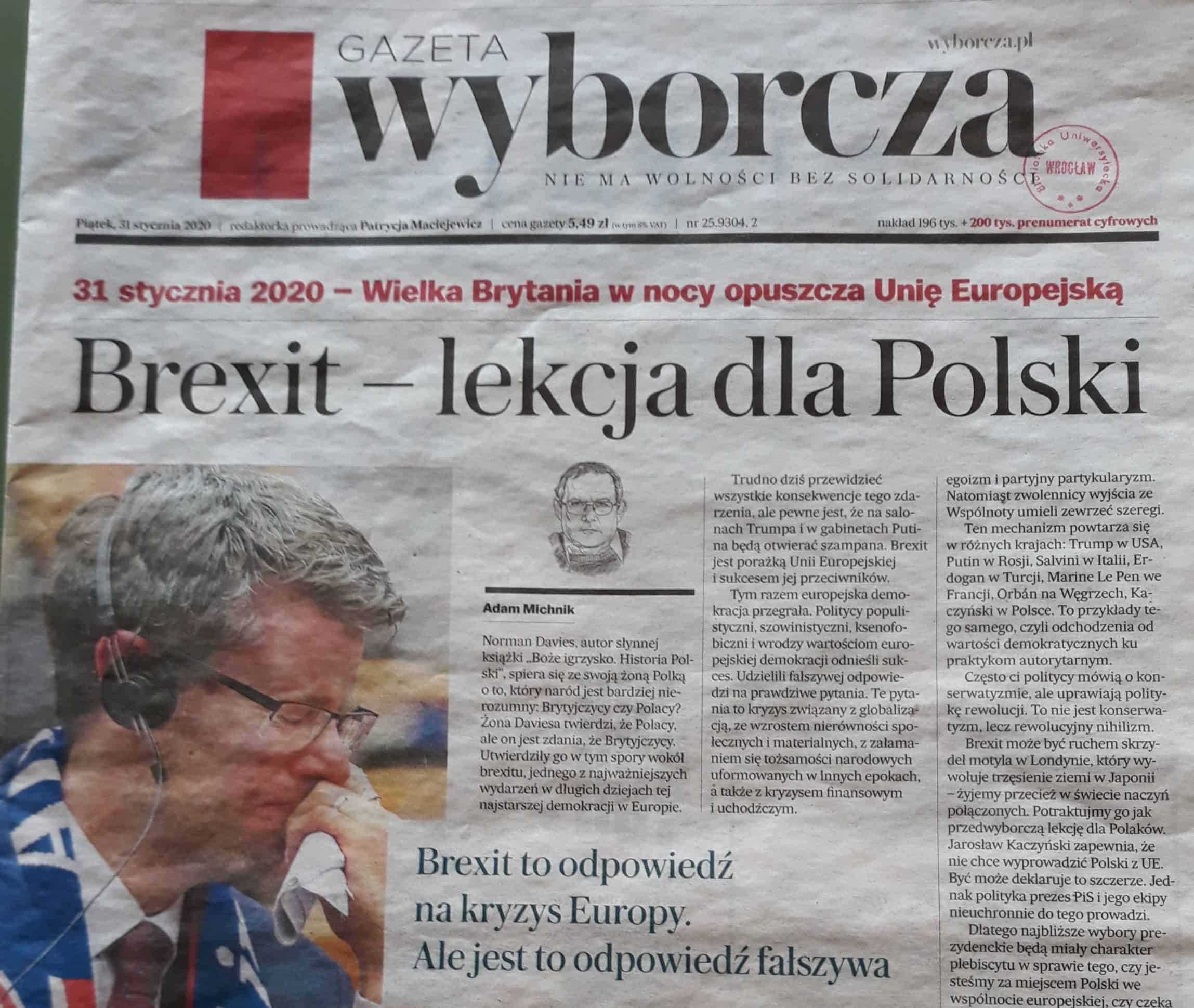
Gazeta Wyborcza editor-in-chief Adam Michnik says that Brexit is the wrong response to the European crisis.
Both Gazeta Wyborcza and Rzeczpospolita covered the subject extensively, mostly on 31 January, when both devoted the front pages of their print editions to Brexit. Gazeta Wyborcza’s front page featured an editorial by editor-in-chief Adam Michnik headlined “Brexit – a lesson for Poland”. Rzeczpospolita’s front-page opinion piece was headlined “Abandoned Europe”. Both articles took a negative view of Brexit in terms of its likely impact on Poland and Europe as whole.
In addition to the front-page coverage, both papers on Friday devoted the next five pages to Brexit-related articles. Gazeta Wyborcza described it as the “Topic of the day”, while Rzeczpospolita gave several inside pages a special Brexit header made up of the British and EU flags.
On 31 January, both papers described events marking the occasion in Brussels and the UK, and provided their readers with background and context (an account of Britain’s relationship with the EU and a timeline of the Brexit from process from 2016 onwards). Gazeta Wyborcza focused slightly more on the political aspect, while Rzeczpospolita’s main focus was the economic consequences.
On 1 February, both papers carried more opinion pieces. Gazeta Wyborcza had commentaries by the British historian Timothy Garton Ash, while Rzeczpospolita featured articles by Irish Taoiseach Leo Varadkar and British Foreign Secretary Dominic Raab. Gazeta Wyborcza also had an interview with former British Prime Minister Tony Blair.
Fakt paid rather less attention to Brexit. On 31 January, it published just one article (on p.5 of the print edition) describing the potential fallout of Brexit for Polish citizens, with the headline “Will Brexit harm you?”. On 1 February it ran an interview with the Polish Minister of Agriculture headlined “Polish farmers will lose after Brexit” (again on p.5, though a teaser did appear on p.1).
 Portugal
Portugal
EJO’s analysis of Brexit coverage in the Portuguese press is based on how the topic was handled by the three main national print dailies: Público, Correio da Manhã (both published in Lisbon) and Jornal de Notícias (published in Porto). (Portugal’s oldest surviving national daily, Diario de Notícias, switched to online daily production in 2018, with a weekly print edition on Saturdays.)
None of these papers has a clear political allegiance. Público has a more international focus than Correio da Manhã and Jornal de Notícias. The Porto-based Jornal de Notícias caters more for readers in the north of the country.

Portugal’s Público described the Brexit process as “divisive and chaotic”.
Público covered the issue the most extensively: Brexit dominated its front pages on both 31 January and 1 February. Inside, it devoted around 20 pages to the issue across both days, covering a wide range of themes. The main aspects covered included economic impacts, potential repercussions for Portuguese people resident in the UK, and the increased possibility of Scottish independence and the reunification of Ireland.
Jornal de Notícias also put Brexit on its front page on both days, though it was not the top story. On each day, it devoted two pages to the issue, and focused mainly on the likely impact for Portuguese people, especially those living in the UK. On 1 February, it also touched on the Scottish and Irish themes. And on the same day, the main story in the paper’s finance supplement was the economic impact of Brexit.
Correio da Manhã did not cover the issue on its front page on either day, though it did have a few articles about it on inside pages. These mainly focused on the implications for Portuguese people resident in the UK, though on 1 February it also carried a report on how Brexit Day was marked in London.
 Ukraine
Ukraine
Several Ukrainian media outlets covered Brexit Day on both 31 January and 1 February, but for the majority it was not the top story. Three news websites were selected for more detailed analysis. The moderately left-of-centre LB.ua and the moderately right-of-centre DT.ua – both among the most reputable news sources in Ukraine – covered the issue in some depth, focusing on the implications of Britain’s departure from the EU. The more downmarket fakty.ua confined itself to a few Brexit-related news items.
The main angle dominating coverage in all news media was the likely impact of Brexit on Britain; the future of the EU received less attention. One article in DT.ua was in general quite optimistic with regard to the possible political repercussions. It mentioned the sharp differences of opinion within Britain over the issue and paid attention to the political and economic angles, but it also highlighted symbolic elements such as the countdown clock projected onto Downing Street and the new 50p coin. LB.ua’s coverage was more neutral and focused on the political and economic implications for Britain.
Brexit’s impact on Ukraine-UK relations also received a good deal of attention, especially the implications for visa agreements between the two countries. An article in LB.ua also pointed out some less obvious implications for Ukraine. For example, it mentioned the possibility of new trade agreements between Ukraine and Great Britain, which it said could be to the advantage of the Ukrainian agricultural sector, which at present has to comply with the very strict current EU rules.
About the project
Sad farewell or new dawn? Europe’s media reflect on ‘Brexit Day’ is part of an ongoing collaborative journalistic research project by the European Journalism Observatory.
It can also be read on the following EJO sites:
- Czech: Truchlení nebo nová příležitost? Jak evropská média informovala o „Brexit Day“
- German: Brexit: Trauriger Abschied oder Neustart?
- Italian: Triste addio o nuova era? I media europei riflettono sul “Brexit Day”
- Polish: Smutne pożegnanie czy nowy początek? Reakcja mediów w Europie w dniu Brexitu
- Portuguese: Triste despedida ou novo amanhecer – Como os media Europeus abordaram o “Brexit Day”
- Ukrainian: Сумне прощання чи новий початок? Як європейські медіа відреагували на день Брекзиту
Methodology
The analysis was conducted at seven universities and research institutes across Europe. Contributors analysed the Brexit-related coverage of a range of newspapers and news websites on 31 January and 1 February 2020.
EJO network
Project coordinator and writer
Paula Kennedy, editor of EJO English, Reuters Institute for the Study of Journalism, University of Oxford
Contributors
Sandra Štefaniková, Charles University, Prague, EJO Czech Republic
Tina Bettels-Schwabbauer, Erich-Brost-Institut, TU Dortmund, EJO Germany
Philip di Salvo and Antonio Nucci, Universita della Svizzera italiana (USI), Lugano, EJO Italy
Michal Kuś and Adam Szynol, Wrocław University, EJO Poland
Ana-Pinto Martinho, University Institute of Lisbon, EJO Portugal
Halyna Budivska, National University of “Kyiv-Mohyla Academy”, Kiev, EJO Ukraine
Images: photos of European press supplied by EJO editors.
If you liked this story, you may also be interested in Will It Kill Us Or Make Us Stronger? How Europe’s Media Covered Brexit
Sign up for the EJO’s regular monthly newsletter or follow us on Facebook and Twitter.
Tags: BREXIT, European Press, European Union


